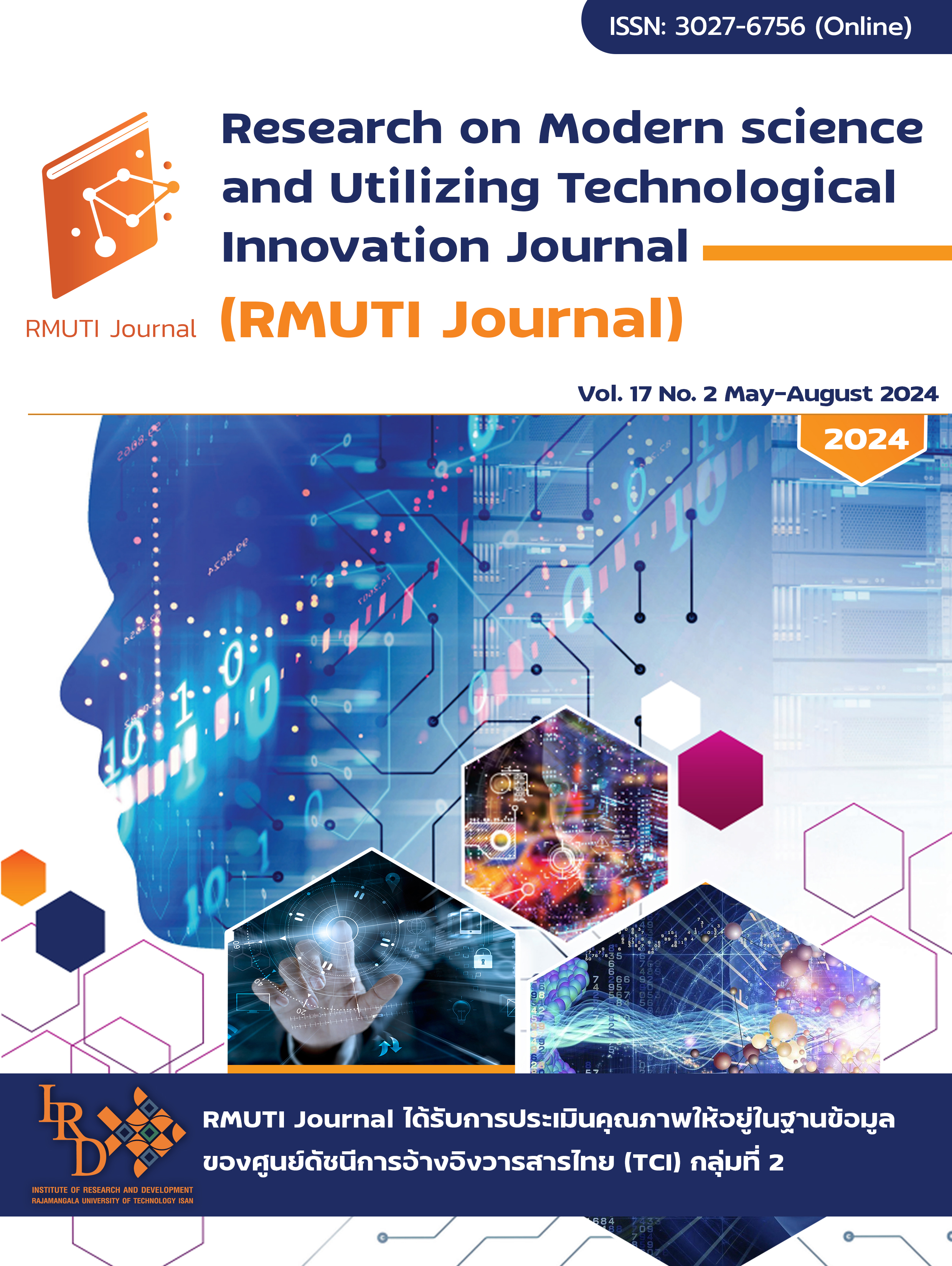A Mixed-Integer Programming Model for Solving a Two-Level Location-Routing Problem in Biomass Supply Chains
Main Article Content
Abstract
This study presents a mixed-integer programming model to address the location and routing problem for optimizing a two-level biomass supply chain. The primary objective is to select collection points and determine transportation routes from forest areas to collection points and from these points to biorefineries to minimize the total cost. While the initial model is non-linear, a linearization approach facilitates efficient solution finding. Real-world biomass data is used to evaluate the model's effectiveness. The results demonstrate that the two-level routing strategy significantly reduces overall costs by up to 12.92 % compared to a single-level approach. Consequently, the findings of this study can enhance the logistics efficiency of the biomass supply chain in Thailand, promoting the sustainable development of biomass energy in the future.
Article Details

This work is licensed under a Creative Commons Attribution-NonCommercial-NoDerivatives 4.0 International License.
References
Department of Alternative Energy Development and Efficiency, Ministry of Energy of Thailand. (2020). Alternative Energy Development Plan 2018-2037 (AEDP 2018-2037). Access (15 May 2024). Available (https://policy.asiapacificenergy.org/node/4351)
Bowling, I. M., Ponce-Ortega, J. M., and El-Halwagi, M. M. (2011). Facility Location and Supply Chain Optimization for a Biorefinery. Industrial & Engineering Chemistry Research. Vol. 50, No. 10, pp. 6276-6286. DOI: 10.1021/ie101921y
Johnson, D. M., Jenkins, T. L., and Zhang, F. (2012). Methods for Optimally Locating a Forest Biomass-to-Biofuel Facility. Biofuels. Vol. 3, Issue 4, pp. 489-503. DOI: 10.4155/bfs.12.34
Woo, H., Acuna, M., Moroni, M., Taskhiri, M. S., and Turner, P. (2018). Optimizing the Location of Biomass Energy Facilities by Integrating Multi-Criteria Analysis (MCA) and Geographical Information Systems (GIS). Forests. Vol. 9, Issue 10, DOI: 10.3390/f9100585
Nguyen, D. H. and Chen, H. (2018). Supplier Selection and Operation Planning in Biomass Supply Chains with Supply Uncertainty. Computers & Chemical Engineering. Vol. 118, pp. 103-117. DOI: 10.1016/j.compchemeng.2018.07.012
Costa, Y. and Melo, T. (2024). Facility Location Modeling in Supply Chain Network Design: Current State and Emerging Trends. In: Sarkis, J. (eds) The Palgrave Handbook of Supply Chain Management. Palgrave Macmillan, Cham. DOI: 10.1007/978-3-031-19884-7_101
Solomon, M. (1987). Algorithms for the Vehicle Routing and Scheduling Problems with Time Window Constraints. Operations Research. Vol. 35, No. 2, pp. 254-265
Tan, S.-Y. and Yeh, W.-C. (2021). The Vehicle Routing Problem: State-of-the-Art Classification and Review. Applied Sciences. Vol. 11, Issue 21, DOI: 10.3390/app112110295
Gracia, C., Velazquez-Martı´, B., and Estornell, J. (2014). An Application of the Vehicle Routing Problem to Biomass Transportation. Biosystems Engineering. Vol. 124, pp. 40-52. DOI: 10.1016/j.biosystemseng.2014.06.009
Allen, J., Browne, M., Hunter, A., Boyd, J., and Palmer, H. (1998). Logistics Management and Costs of Biomass Fuel Supply. International Journal of Physical Distribution & Logistics Management. Vol. 28, No. 6, pp. 463-477. DOI: 10.1108/09600039810245120
Searcy, E., Flynn, P., Ghafoori, E., and Kumar, A. (2007). The Relative Cost of Biomass Energy Transport. Applied Biochemistry and Biotechnology. Vol. 137, pp. 639-652. DOI: 10.1007/s12010-007-9085-8
Perpina, C., Alfonso, D., Pérez-Navarro, A., Penalvo, E., Vargas, C., and Cárdenas, R. (2009). Methodology Based on Geographic Information Systems for Biomass Logistics and Transport Optimisation. Renewable Energy. Vol. 34, Issue 2, pp. 555-565. DOI: 10.1016/j.renene.2008.05.047
Sajida, K., Nazir Maryam, S., Kausar, N., Agarwal, P., Ozbilge, E., and Bulut, A. (2023). Optimizing Transportation Cost for Biomass Supply Chain. Thermal Science. Vol. 27, Special Issue 1, pp. S245-S251
Cooper, L. (1972). The Transportation-Location Problem. Operations Research. Vol. 20, No. 1, pp. 94-108. DOI: 10.1287/opre.20.1.94
Drexl, M. and Schneider, M. (2015). A Survey of Variants and Extensions of the Location-Routing Problem. European Journal of Operational Research. Vol. 241, Issue 2, pp. 283-308. DOI: 10.1016/j.ejor.2014.08.030
Ransikarbum, K., Wattanasaeng, N., and Madathil, S. C. (2023). Analysis of Multi-Objective Vehicle Routing Problem with Flexible Time Windows: The Implication for Open Innovation Dynamics. Journal of Open Innovation: Technology, Market, and Complexity. Vol. 9, Issue 1, DOI: 10.1016/j.joitmc.2023.100024
Yunusoglu, P., Ozsoydan, F. B., and Bilgen, B. (2024). A Machine Learning-Based Two-Stage Approach for the Location of Undesirable Facilities in the Biomass-to-Bioenergy Supply Chain. Applied Energy. Vol. 362, DOI: 10.1016/j.apenergy.2024.122961
Yeng, F. F., Zainuddin, Z. M., and Pheng, H. S. (2024). Optimizing Palm Oil Biomass Supply Chain Logistics through Multi-Objective Location-Routing Model. Malaysian Journal of Fundamental and Applied Sciences (MJFAS). Vol. 20, No. 2, pp. 247-265
Cao, J. X., Zhang, Z., and Zhou, Y. (2021). A Location-Routing Problem for Biomass Supply Chains. Computers & Industrial Engineering. Vol. 152, DOI: 10.1016/j.cie.2020.107017
Wang, C., Cao, T., Nguyen, D. D., and Dang, T. (2024). Bi-Objective Optimization Modeling for Biomass Supply Chain Planning. Measurement and Control. Vol. 362, DOI: 10.1177/00202940241226603
Xu, R., Huang, Y., and Xiao, W. (2023). A Two-Level Variable Neighborhood Descent for a Split Delivery Clustered Vehicle Routing Problem with Soft Cluster Conflicts and Customer-Related Costs. Sustainability. Vol. 15, No. 9, pp. 1-22
Ghasemi, P., Hemmaty, H., Chobar, A. P., Heidari, M. R., and Keramati, M. (2023). A Multi-Objective and Multi-Level Model for Location-Routing Problem in the Supply Chain Based on the Customer’s Time Window. Journal of Applied Research on Industrial Engineering. Vol. 10, Issue 3, pp. 412-426. DOI: 10.22105/jarie.2022.321454.1414


